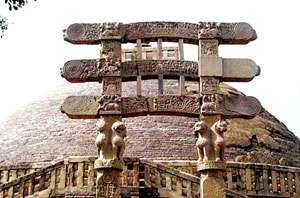Little Blue Birdie’s Diary
Sanchi Vihara: A popular religious site
This year, we celebrated the Thrice-Blessed Day,Vesak at the Sanchi
Vihara in India. While attending all the religious activities here, we
thought of visiting some of the temples as well.
Sanchi is one of the most popular Buddhist religious sites in the
world, but is also well known for its archaeological significance. It is
50 kms from Bhopal and is famous for its numerous stupas.

The place is related to Buddhism, but not directly to the life of the
Buddha. King Asoka built the first stupa here and also put up many
pillars at the site. The crown of the famous Asoka pillars, with four
lions standing back to back, had later been adopted as the national
emblem of India.
Sanchi remained neglected for so many years and was rediscovered in
1818; the marvellous pieces of structure were not in good shape at the
time of discovery.
Gradually, the historical and religious significance of the place was
recognised. The restoration work of the stupas started in 1881 and
finally, between 1912 and 1919, these were carefully repaired and
restored.

It is accepted that the structures at Sanchi were some of the most
organised constructions of that era. King Asoka originally constructed
the Sanchi Stupa in the Third Century BC. It is 16 metres high and 37
metres in diameter, with a railing surrounding it.
The best preserved is the northern gateway, upholding a broken ‘wheel
of law’, whereas the oldest is the southern gateway. Pillar No. 10 was
erected by Emperor Asoka himself and is close to the southern entrance
to the great stupa.

Halfway down the hill, to the west, sits a second stupa, with
‘medallions’ decorating the surrounding walls with lovely motifs. It
contained relics of important Buddhist teachers, and it is because the
teachers were lower in stature to the Buddha and His direct disciples
that this stupa is positioned lower than the great stupa.
The third stupa stands north east of the main stupa and although
smaller, resembles the great one. It once contained the relics of two of
the Buddha’s most important disciples.
There are two other big stupas, (one of them is in a very bad
condition, and many small ones) and some less than a metre high. To the
south of the great stupa is a chaitya and a smaller temple, both
reminiscent (reminding) of Greek architecture. There are traces of
wooden viharas or monasteries on the site.

The great stupa No. 1 is the oldest stone structure in India, 36.5
metres in diameter and 16.4 metres high, and with a massive
hemispherical (half-circular) dome. The stupa stands in eternal majesty,
the paved path for processions around it worn smooth by centuries of
pilgrims.
Stupa No. 2 stands at the very edge of the hill and its most striking
feature is the stone balustrade that rings it.
The four gateways constructed in Sanchi are the best form of Buddhist
expression one can find anywhere in the world. Gateways or thoranas as
they are called are covered with carvings which depict scenes from the
life of the Buddha and Jatakas, the stories relating to the Buddha and
His earlier births.
At this stage, the Buddha was not represented directly, but symbols
were used to portray Him; the lotus represented His birth, the tree His
Enlightenment, the wheel, derived from the title of His first sermon and
the footprints symbolising His presence.
The pillars are scattered in the area; some of these are broken while
some are in good shape. The Asoka pillar is on the southern entrance.
Today, only its shaft stands here while the crown is kept in a
museum. The crown consists of the famous four lions, standing back to
back.
The Asoka pillar is an excellent example of the Greco-Buddhist style
and is known for its aesthetic proportions and exquisite structural
balance.
The Buddhist Vihara
The earlier monasteries were made from wood, which was elegantly
carved and attractively decorated. The present monasteries are not even
a shadow of what they were in the past.
A few kilometres from Sanchi are the relics of the Satdhara Stupa.
The relics are kept in a glass casket, which is placed on the inner
sanctum of the modern monastery. Sanchi had a huge bowl carved out of a
single rock. Grain used to be stored in this bowl to be distributed
among monks in Sanchi.
The Gupta Temple
This temple is now in ruins. However, whatever is left tells a tale
of greatness and a temple which had no match during its times. The
temple was built in the Fifth Century and is an excellent example of
ancient temple architecture in India.
|
